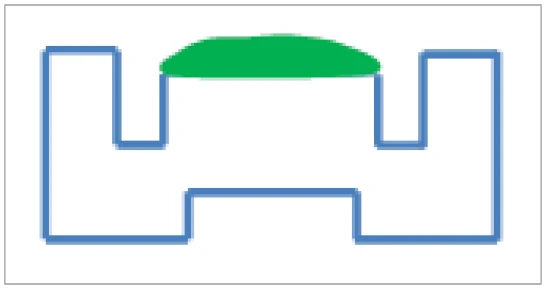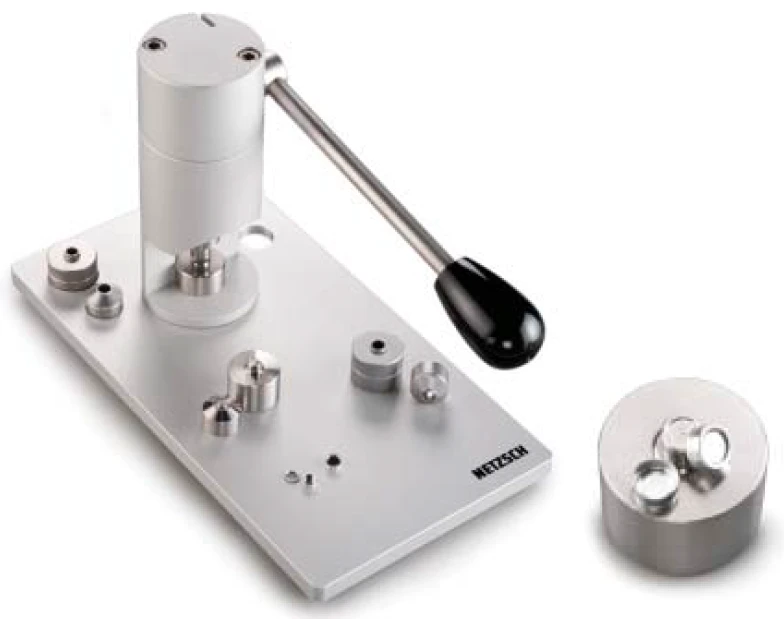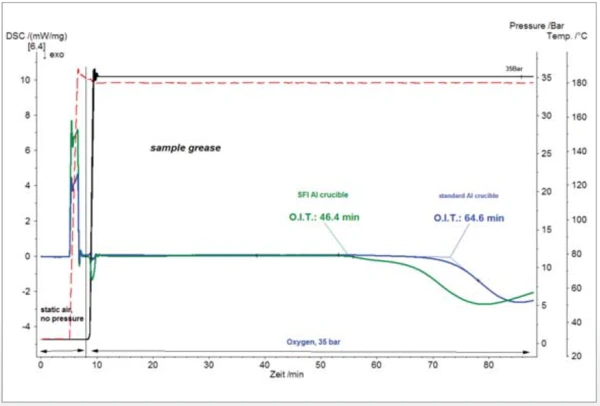Introduction
External influences such as UV radiation (light), temperature, atmospheric oxygen or chemical/biological media lead to premature aging in materials, resulting in a change in their chemical and physical properties. Proper aging inhibitors (stabilizers) slow down the aging process and prolong the induction period, i.e. the time span preceding the onset of thermo-oxidative Decomposition reactionA decomposition reaction is a thermally induced reaction of a chemical compound forming solid and/or gaseous products. decomposition (chain degradation, technical failure).
An important indicator of the OxidationOxidation can describe different processes in the context of thermal analysis.oxidation stability of oils, fats, lubricants, fuels or plastics is the Oxidative-Induction Temperature or Oxidative-Induction Time (Oxidative-Induction Time (OIT) and Oxidative-Onset Temperature (OOT)Oxidative Induction Time (isothermal OIT) is a relative measure of the resistance of a (stabilized) material to oxidative decomposition. Oxidative-Induction Temperature (dynamic OIT) or Oxidative-Onset Temperature (OOT) is a relative measure of the resistance of a (stabilized) material to oxidative decomposition.OIT) which can be determined by means of DSC in standardized procedures.
In practice, two different methods are used: dynamic and IsothermalTests at controlled and constant temperature are called isothermal.isothermal Oxidative-Induction Time (OIT) and Oxidative-Onset Temperature (OOT)Oxidative Induction Time (isothermal OIT) is a relative measure of the resistance of a (stabilized) material to oxidative decomposition. Oxidative-Induction Temperature (dynamic OIT) or Oxidative-Onset Temperature (OOT) is a relative measure of the resistance of a (stabilized) material to oxidative decomposition.OIT tests. In the dynamic technique, the sample is heated at a defined constant heating rate under oxidizing conditions until the reaction begins. The corresponding Oxidative-Induction Temperature (also called OxidationOxidation can describe different processes in the context of thermal analysis.Oxidation Onset Temperature, Oxidative-Induction Time (OIT) and Oxidative-Onset Temperature (OOT)Oxidative Induction Time (isothermal OIT) is a relative measure of the resistance of a (stabilized) material to oxidative decomposition. Oxidative-Induction Temperature (dynamic OIT) or Oxidative-Onset Temperature (OOT) is a relative measure of the resistance of a (stabilized) material to oxidative decomposition.OOT) is the same as the extrapolated onset temperature of the ExothermicA sample transition or a reaction is exothermic if heat is generated.exothermal DSC effect which occurs. In IsothermalTests at controlled and constant temperature are called isothermal.isothermal Oxidative-Induction Time (OIT) and Oxidative-Onset Temperature (OOT)Oxidative Induction Time (isothermal OIT) is a relative measure of the resistance of a (stabilized) material to oxidative decomposition. Oxidative-Induction Temperature (dynamic OIT) or Oxidative-Onset Temperature (OOT) is a relative measure of the resistance of a (stabilized) material to oxidative decomposition.OIT tests, the materials to be investigated are first heated under a protective gas, then held at a constant temperature for several minutes under protective gas to establish equilibrium, and subsequently exposed to an atmosphere of oxygen or air. The time span from the first contact with oxygen until the beginning of OxidationOxidation can describe different processes in the context of thermal analysis.oxidation is called the Oxidative-Induction Time. This is shown in figure 1.

Many national and international standards – such as ASTM D3895 (polyethylene), DIN EN728 (plastic pipelines), ISO 11357-6 (plastics) and ASTM D525 (aircraft fuel) – give recommendations for sample preparation and proper selection of the measurement conditions.
Oxidation Tests on Lubricating Oils and Greases
OxidationOxidation can describe different processes in the context of thermal analysis.Oxidation tests on lubricating oils and greases are usually carried out using a high-pressure DSC instrument (see figure 2). A back-pressure is generated – generally at 35 bar – in an attempt to prevent evaporation of the sample. In OxidationOxidation can describe different processes in the context of thermal analysis.oxidation reactions, however, the oxygen not only serves for pressure generation, but also as a reaction partner. For this reason, both the pressure and the gas flow must be regulated with the utmost precision.

Determination of the OxidationOxidation can describe different processes in the context of thermal analysis.oxidation stability is “surface- sensitive”. This means that the oil or grease film to be investigated should ideally exhibit a smooth, uniform surface in order to ensure high reproducibility of the test results. Very well suited for such investigations are SFI crucibles (SFI stands for Solid Fat Index; see diagram in figure 3), as recommended in ASTM D5483 for lubricating greases and ASTM D6186 for lubricating oils.

An example of these would be pan-shaped aluminum crucibles with an outer diameter of 6.7 mm and a volume of 85 μl which can be shaped with a sealing tool (built into a standard crucible press – see figure 4).

In crucibles with a flat bottom, oils and fats often CreepCreep describes a time and temperature dependent plastic deformation under a constant force. When a constant force is applied to a rubber compound, the initial deformation obtained due to the application of the force is not fixed. The deformation will increase with time.creep to the rim zones at higher temperatures. The effective surface of the sample which can interact with the surrounding atmosphere is thus reduced in size. This affects the Oxidative-Induction Time (OIT) and Oxidative-Onset Temperature (OOT)Oxidative Induction Time (isothermal OIT) is a relative measure of the resistance of a (stabilized) material to oxidative decomposition. Oxidative-Induction Temperature (dynamic OIT) or Oxidative-Onset Temperature (OOT) is a relative measure of the resistance of a (stabilized) material to oxidative decomposition.OIT results (see figure 5). When the analysis is conducted in an open standard crucible (blue curve), the Oxidative-Induction Time (OIT) and Oxidative-Onset Temperature (OOT)Oxidative Induction Time (isothermal OIT) is a relative measure of the resistance of a (stabilized) material to oxidative decomposition. Oxidative-Induction Temperature (dynamic OIT) or Oxidative-Onset Temperature (OOT) is a relative measure of the resistance of a (stabilized) material to oxidative decomposition.OIT time (extrapolated onset) amount to 64.6 min. In comparison, when analyzed in an SFI crucible (green curve), the OIT is shortened considerably (to 46.4 min) due to the larger effective surface.

Summary
With the help of DSC-OIT tests, comparative conclusions on the stability of materials compared to thermo-oxidative attacks can be drawn. For the investigation of lubricating oils and greases, the NETZSCH High-Pressure DSC 204 in combination with SFI crucibles is ideally suited.